07.01.04 Jn. 5:1-15 Jerusalem. The Second Passover
SABBATH HEALING AT POOL OF BETHESDA
1 After this, a Jewish festival took place, and Jesus went up to Jerusalem. 2 By the Sheep Gate in Jerusalem there is a pool, called Bethesda in Hebrew, which has five colonnades. 3 Within these lay a large number of the sick — blind, lame, and paralyzed
[— waiting for the moving of the water, 4 because an angel would go down into the pool from time to time and stir up the water. Then the first one who got in after the water was stirred up recovered from whatever ailment he had].
5 One man was there who had been sick for 38 years. 6 When Jesus saw him lying there and knew he had already been there a long time, He said to him, “Do you want to get well?”
7 “Sir,” the sick man answered, “I don’t have a man to put me into the pool when the water is stirred up, but while I’m coming, someone goes down ahead of me.”
8 “Get up,” Jesus told him, “pick up your mat and walk!” 9 Instantly the man got well, picked up his mat, and started to walk.
Now that day was the Sabbath, 10 so the Jews said to the man who had been healed, “This is the Sabbath! It’s illegal for you to pick up your mat.”
11 He replied, “The man who made me well told me, ‘Pick up your mat and walk.’”
12 “Who is this man who told you, ‘Pick up your mat and walk’?” they asked. 13 But the man who was cured did not know who it was, because Jesus had slipped away into the crowd that was there.
14 After this, Jesus found him in the temple complex and said to him, “See, you are well. Do not sin anymore, so that something worse doesn’t happen to you.” 15 The man went and reported to the Jews that it was Jesus who had made him well.
List of Characters of John 5:1-9
Man = Israel
Five porches = Five books of the law
Thirty-eight years = Time spent wandering in the desert
Stirring of the waters = Baptism
Some scholars have suggested that this account is an allegory;[1] a story because the event never occurred. Granted, at times it is difficult to determine what has allegorical significance and what doesn’t. Clearly the crippled man and his thirty-eight years at the Pool of Bethesda, meaning the House of Mercy, are reflective of Israel and her journey. But whether the five colonnades (porches) are reflective of the five books of the law is another matter of interpretation. Caution is recommended against reading anything into the text because this narrative has all the factual markings of an actual event. But these allegorical connections do not mean the event never happened. The account of the Samaritan woman also has some allegorical connections, and no critic ever questioned the historicity of John 4:1-42.
This miracle is the third of seven signs identified by John.[2] Yet, this account has a unique mystery and, unfortunately, verses 3b-4 are omitted from the New International Version. The reason these few words (verses 3b-4) are difficult to understand is because this narrative is said to essentially describe a contest to obtain a healing, and that is outside of the character of God. Scholars and translators believe that God does not tease the afflicted, nor does He create a contest in which only the winner is healed. This writer agrees! Therefore, the New International Version translators concluded these verses were not part of the original text. However, this writer believes that to correctly understand this passage, two other issues need to be addressed. They are,
- The geological and climatic issues of the area, and
- The well-established religious cultic context that existed at this site.
The geological reason the water was “stirred” is that Jerusalem was built upon a dolomite limestone mountain which does not retain water very well.[3] Since Israel has a rainy season (winter) and a dry season (summer), in the winter the limestone is saturated and in the summer it is dehydrated. When winter rains begin, the water that seeps through the dry aquifers pushes the air out and into the pool. Hence, the escaping air creates air bubbles and the illusion of a “stirring of the waters.”[4] This was not the only “gaseous” spring found in the Jordan valley and elsewhere.[5] Similar bubbling pools were also found in Babylon, where cuneiform inscriptions called them “holy wells.”[6] The idea that one could get healed when the waters were stirred originated with pagan religions. Those who laid in vain at the Pool of Bethesda were so desperate for a healing that they placed their faith in anything that might give them relief.
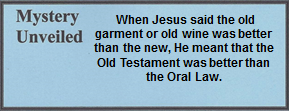
The well-established religious cultic context reason is this: The Greek religions became epidemic after the conquest by Alexander the Great. In the three centuries that preceded Jesus, no one promoted pagan religions more than did Antiochus IV Epiphanes during the years 167-164 B.C. His reign of paganism and terror led to the Maccabean Revolt (see 03.04.20). Even after the Jews won their freedom, those pagan religions were never completely eradicated except within some villages and in the city of Jerusalem. While all signs of paganism were removed from within the Holy City and the temple, the Jews were rather lax about the removal of pagan shrines outside of the city walls, including the Pool of Bethesda. Hellenistic Jews enjoyed these pagan sites. Note the comments written after the Jews won their independence and religious freedom.
All the Gentiles accepted the command of the king. Many even from Israel gladly adopted his religion; they sacrificed to idols and profaned the Sabbath. And the king sent letters by messengers to Jerusalem and the cities of Judah; he directed them to follow customs strange to the land, to forbid burnt offerings in the sanctuary, to defile the sanctuary and the priests, to build altars and sacred precincts and shrines to idols.
1 Maccabees 1:41-47[7]
From the pen of Josephus is another historical account that affirms the widespread construction of pagan shrines and altars.
He also compelled them to forsake their own God and to adore those whom he took to be gods; and made them (the Jews) build temples and raise idols in every city and village and offer swine upon them every day.
Josephus, Antiquities 12.5.4 (253)[8]
As stated previously, the actions of Antiochus led to the Maccabean Revolt. After defeating the Greek tyrant, the Jews sanctified the temple but failed to purge the nation from its love of idols (Gk. eidolothutos 1494, meaning sacrificed to idols) or eradicate all pagan sites outside of the Holy City.[9] These idols were not only worshiped by Hellenistic Jews, but also by local Gentiles. Later, Herod the Great, who was also a devout pagan, built a temple for emperor worship in Samaria and encouraged pagan worship outside Jerusalem for the sole purpose of strengthening his position with Rome. Therefore, there is an excellent case to be argued that the place where Jesus performed this miracle had a strong pagan history – and desperate people will consider desperate measures to obtain their healing.
There is also a theological explanation for John 5:3b-4.[10] He made reference to “an angel would go down,” who would stir the waters. However, in those days, all gods were called “Lord” or by their name. This writer suggests that the invalid was waiting for an angel of an unknown god, most likely Asclepius, to heal him, but instead, it was Jesus who healed him. Whether the term “lord” is a reference to the God of Abraham, Isaac, and Jacob, or a reference to a pagan deity is called a “textual problem.”[11] In this case as with others in Scripture, it probably was a demonic angel.[12] Visitors today at the pool will see archaeological evidence and a sign indicating that this pool was at one time the Sanctuary of Asclepius (also spelled “Aesculapius”).[13]
In Greek cities, any place that was said to be a site of healing became a sanctuary to Asclepius, and became a focal point for many invalids and tourists. For example, archaeologists in Corinth have uncovered a building complex dedicated to Asclepius with facilities for bathing, dining, exercise, and sleeping (for dreams).[14] Sick persons would come and a dedication of healing was prayed using a reproduced body part (such as an arm or leg), which was made from bronze, marble, or terra cotta.[15] Any healing that was received, even if by natural recovery, was accredited to Asclepius.[16] Therefore, when Jesus healed the man, He demonstrated that He was greater than Asclepius – the Greek god of healing.
Pagan worship and traditions instituted by Antiochus IV Epiphanes in the previous century continued, to a limited extent, into the days of Jesus. One of the major social issues between orthodox Jews and Hellenistic Jews was that the latter honored pagan gods and traditions. Epiphanies had directed his men “to build altars and sacred precincts and shrines for idols and to sacrifice swine and unclean animals” (1 Macc. 1:47).[17] Ironically, the Pool of Bethesda was built about 200 B.C., just prior to the zenith of Greek paganism in Jerusalem, for the purpose of washing sheep that would be sacrificed in the temple. Yet air bubbles coming out of the limestone aquifers were credited to be the stirring of an angel of a pagan lord or deity.
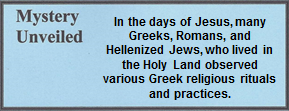
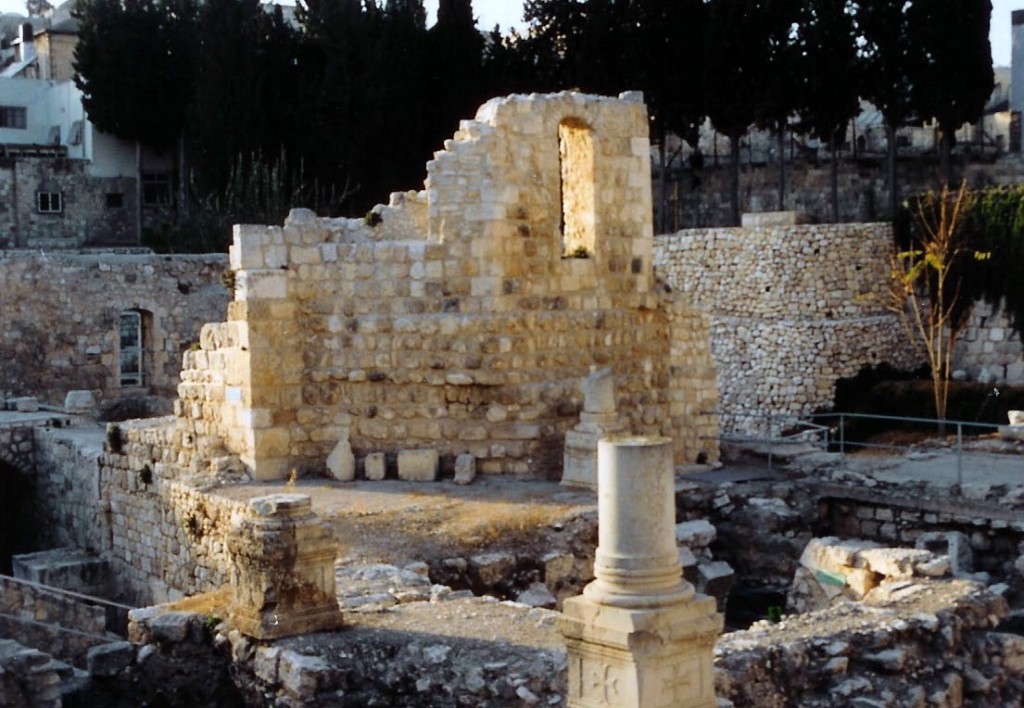
07.01.04.A. RUINS OF THE POOL OF BETHESDA. The Pool of Bethesda has been identified by the foundations of the pool and its close proximity to the Sheep Gate. Archaeologists uncovered the ruins of a sanctuary to the healing god Asclepius built by Hadrian (A.D. 132-135). They believe Hadrian constructed this sanctuary on the ruins of a previous shrine built by Antiochus IV Epiphanies in the early 2nd century B.C. It is highly possible that the site had a legacy of healing at the time of Jesus. Photograph by the author.
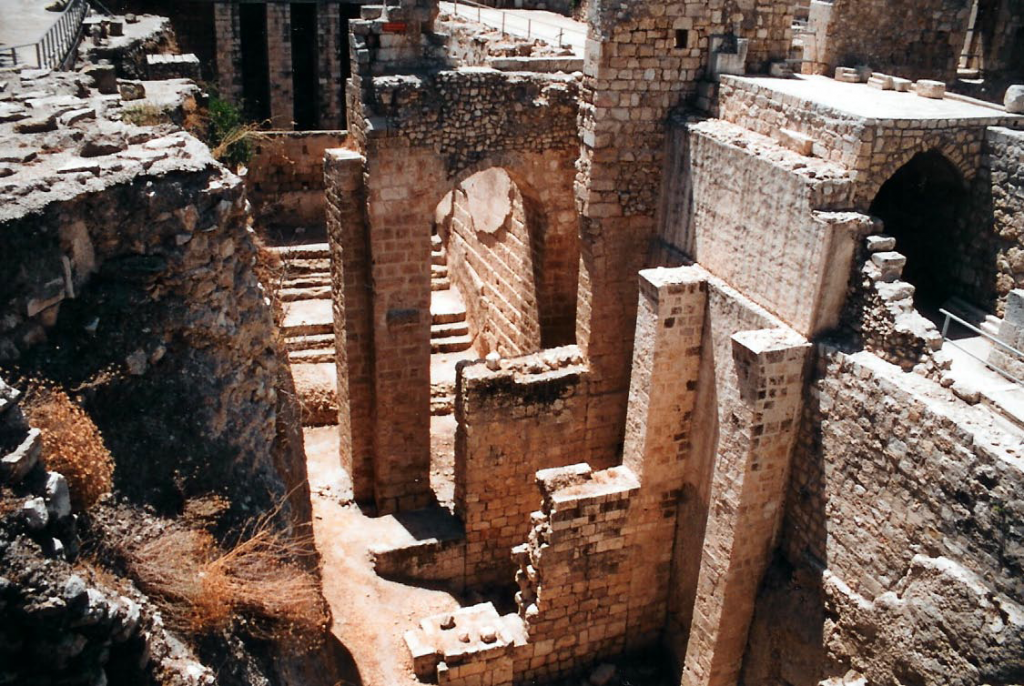
07.01.04.B. THE INTERIOR OF THE RUINS OF THE POOL OF BETHESDA. The Pool of Bethesda today is a dry and dormant archaeological site, and rather deep. Over the centuries, due to the many destructions of Jerusalem, the elevation of the city has been raised creating the appearance that the pool was much deeper than it really was. During the first and second century B.C., hundreds of Hellenized Jews, Greeks, and Romans, came to the pool to receive a healing, caring little for which god or God healed them. Photograph by the author.
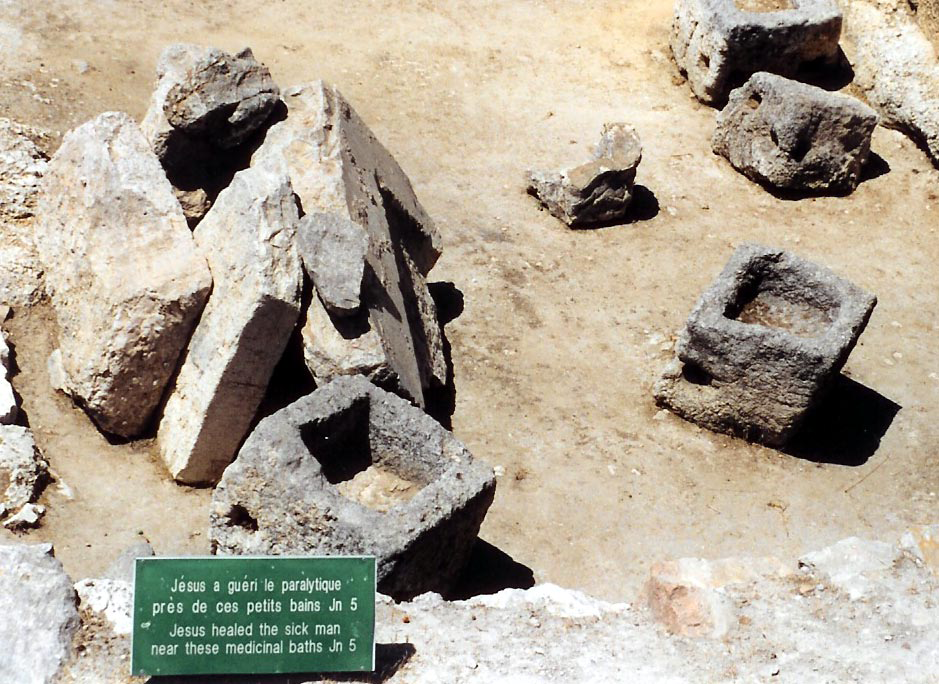
07.01.04.C. ASCLEPIUS ARTIFACTS FROM THE POOL OF BETHESDA. Artifacts from the cult of Asclepius found at the Pool of Bethesda. History and archaeology suggest that the pool was a pagan site for the Greek god of healing, Asclepius. Photograph by the author.
It is also a well-known fact that holy sites usually remained sacred when one people group replaced another. In this case, a holy site established by the Greeks remained a holy site long after the Roman conquest. Archaeological discoveries reveal that the Romans came to this site for healing after the destruction of Jerusalem in A.D. 135.[18]
Furthermore, emperors and rulers frequently claimed to be gods as a method to strengthen their control on the general population. Stories were created in which they claimed to have been born of a virgin or to have performed miracles. Likewise, priests claimed people were healed to encourage offerings. For example, the following account is from a speech recorded in the second century (A.D.) regarding the healing powers of a water well at the Temple of Asclepius in Corinth.
But the god also uses it in other ways like any other co-worker and the well has often assisted many people in obtaining from the god what they desired. For just as the sons of doctors and magicians have been trained to serve them and, while they aid them astound spectators and customers, so this well is the discovery and possession of the great magician who does everything for the safety of mankind. It aids him in everything and for many men is like a drug. For many, by bathing in it, have recovered their sight and many by drinking it have been cured of chest trouble and regained the breath of life. It has cured one man’s feet and another part of the body for someone else. Once someone drank it and spoke after being mute, just as those who drink the forbidden waters and have become prophetic. For some merely drawing up the water has been like a means of safety. And, thus, to the sick it is an antidote and a cure and for those in health, who reside nearby, it makes the employment of all other waters subject to blame.
Aelius Aristides, “Regarding the Well in the Temple of Asclepius.” Speech 39:14-15[19]
This temple, like other temples associated with Asclepius, served as a hospital and had an enormous encampment of sick people waiting to be healed, while doctors practiced their craft.[20] Another second century (A.D.) writer recorded the account of a false prophet by the name of Alexander, who evidently was rather deceptive.
Alexander had secretly prepared a deception by depositing an egg, in which he had placed a small snake, at the base of the newly constructed temple, which he then “finds” and presents as the god Asclepius. Before doing this, he assembles a crowd and speaks of the imminent good fortune of the city that was about to receive the god in visible presence. The crowd – almost the whole city, including women, old men, and boys, had come running – marveled, prayed, and made obeisance. Uttering a few meaningless words like Hebrew or Phoenician, he dazed the creatures, who did not know what he was saying save only that he everywhere brought in Apollo and Asclepius.
Lucian of Samosata, Alexander the False Prophet 13[21]
Still, the writings of another healer, found in an inscription dated AD 484, preserved the belief that Asclepius was the healer of men. However, stories as this are much older than the inscription. The date of when the account originated is not as important as knowing that such belief systems were widespread in the ancient world (see comment on Mt. 8:28-34). The following account concerns a man with a stomach ulcer:
While he slept, he had a dream (in which)[22] the god appeared to him and ordered his assistants to hold him so that the god could cut out the affected part. The man tried to escape, but he was seized and fastened to the door. Asclepius then opened up his stomach, cut out the ulcer, sewed him up again, and finally released him. The man awoke cured but the floor was covered with blood.
Inscription of Epidaurus[23]
In the past century archaeologists uncovered nearly sixty inscriptions and papyri concerning the healing cult of Asclepius. Records were found which indicate physicians used their personal wealth to establish shrines and altars to the Greek god.[24] However, Luke, a Gentile physician, was incredibly detailed concerning the miracles he recorded, attributing them to the power of Jesus.
In the study of John 5:1-15, it is easy to place the focus of attention on the healing or Sabbath violation, but the real focus is on the legalism of the Pharisees. The Jewish leaders were dead in their legalism, which is evident by their complete lack of compassion for anyone who was poor, sick, lame, crippled, or had another affliction. These legalists were overtly self-righteous with a powerful, condemning attitude toward anyone who did not agree with them. They exalted themselves with a demanding set of “do and don’t” regulations (cf. Rom. 6; Gal. 2:4). They could not begin to understand the grace and mercy that Jesus preached and demonstrated. In their thinking, grace and mercy were licenses to sin. Furthermore, the fact that the man was sick for years was proof to them that either he or his family had sinned; hence, there was no need for mercy for him. The idea that an accident or illness could be the natural result of a fallen world had never occurred to them. But when the poor guy got healed, instead of celebrating, they criticized him for violating their Sabbath regulations. Jesus then told him to carry his mat (a blanket), which was another Sabbath violation according to their Oral Law.
Video Insert >
07.01.04.V1 The Invalid Man at the Pool of Bethesda. Dr. Paul Wright and Professor Gordon Franz discuss the invalid man who spent 38 years at the Pool of Bethesda, as a reflection of national Israel.
A question that is almost never asked is this: “Why was a Jewish man trying to get a healing by the Pool of Asclepius (Bethesda)…or at any pool for that matter? The answer is that he, like most people of Israel, had left their God as did many of their forefathers. Notice the comments by Professor Gordon Franz.
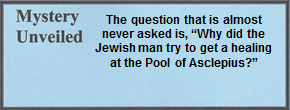
“A Jewish festival.” The identity of this feast is not given, but scholars believe it was the Festival of Passover, Unleavened Bread, and First Fruits,[25] commonly referred to as “the Jewish Festival,” or just “Passover.” There were no other feasts at this time of year. If this is correct, then John referred to four Passovers (Jn. 2:13; 5:1-16; 5:4 and the Last Supper) making the length of the ministry three and a half years (the majority view), or possible four and a half years (a minority view).
“By the Sheep Gate.” Technically, this entire phrase should read: “Now in Jerusalem, by the Sheep [Gate], there is a pool with a Hebrew name Bethesda.”[26]
“In Jerusalem there is a pool.” The phrase reads is, not was, thereby clearly indicating the pool existed at the writing of this gospel. The pool was destroyed during the Roman siege in A.D. 66-70. Therefore, this is clear evidence that this gospel was written within four decades after Jesus, that is, before the destruction of the temple and Jerusalem. Amazingly, some critics argue without evidence that John was written after the destruction of Jerusalem.[27]
“In Hebrew.” Some translators believe the word in this case was Aramaic. However, the more accurate translation is “Hebrew.” Nonetheless, Aramaic and Hebrew are sister languages, and this issue is of little or no significance because Aramaic was generally the language of the day, commonly used in business and other affairs of daily life among the Jews. Hebrew was spoken in synagogues, at religious events, and used in legal documents. Jewish scholars, however, often spoke only Hebrew as not to be associated with the common people who were called am-ha-arets, meaning unlearned.[28]
The use of Hebrew was confirmed in the Dead Sea Scrolls, where various inscriptions and other fragments written by the Jews which are seldom found to be in Aramaic, Greek, or Latin. At Masada, Hebrew writings were found on fourteen scrolls, 4,000 coins, and 700 ostraca.[29] Hebrew writings were more common than Aramaic writings by a ratio of nine to one.[30] Hence, there is a growing opinion in scholarship that Hebrew was the common language in first century Israel, especially among orthodox Jews. It appears that those who were orthodox in their faith definitely maintained the Hebrew language in worship and in social settings, a lifestyle not necessarily shared by Hellenistic Jews who probably used Aramaic or Greek.
07.01.04.Q1 What is the significance of this invalid man having suffered for thirty-eight years (Jn. 5:1-15)?
Many translators use the word “invalid” rather than “sick,” which suggests that his physical condition existed since birth. His life and the lives of other handicapped people were reduced to begging with no hope or purpose for which to live. Most certainly all of them wanted to be healed and, Jesus, with love and compassion, met their needs. But among them was one who was “sick for 38 years.” The cause of this man’s illness is unknown. Yet God had a purpose for him because, not only would he tell others of the love of Jesus, but his illness was a reflection upon the Israelite people who wandered for 38 years in the wilderness from Kadesh-barnea to the Zered Brook. A summary is as follows: After the Israelites left Egypt, they accepted the false report about Canaan from eight of the ten spies. As a result, God punished them to wander in the desert. It was only after nearly four decades of life in the crippling hot desert that they entered into their Promised Land. The impotent man symbolized the impotent nation. It is Jesus who takes any person from a spiritual wilderness, regardless of why, how long, or what the situation was, into the full enrichment of life by faith in Him. He came to give life and to give it more abundantly to anyone who desires it (Jn. 10:10). Jesus healed the man and He wanted to heal the nation, but the nation rejected Him.
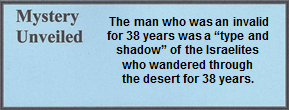
A point of interest pertains to why the Jewish invalid man was by the pagan pool, in the first place, waiting to be healed. Did he not have faith in God? Why didn’t he go to his rabbi and ask for prayer? No wonder that Jesus asked him, “do you want to get well?” The question seems to be rather unkind. It was asked to determine if the man really desired good health, if he had faith in the Greek god Aesclapius, or if he preferred to remain in his hopeless state and dwell in self-pity. There were many beggars in the land, and many of them identified themselves with their disability. Getting healed also meant that one could no longer beg for money and would have to work for a living. Therefore, the question was asked, Do you want to get well? And that may have implied, or would you prefer to continue begging the rest of your life and have people feel sorry for you?
For a quick historical review, scholars believe that in the Inter-Testamental Period, when the Greeks dominated this area, this was a pool dedicated to the Greek god Asclepius – the Greek god of healing. After the Maccabean Revolt, all signs of paganism were removed from within Jerusalem, but this pool was on the outside of the city wall. Therefore, it is believed that it was still honored by the local Gentiles and Roman soldiers. Archaeologists have clearly demonstrated that in the 3rd and 4th centuries (A.D.) this was an active shrine to Asclepius. As to the crippled man, while he was waiting for a healing from a pagan god, Jesus came along and healed him. Without a word spoken, Jesus demonstrated that He was God!
“Get up,” Jesus told him, “pick up your mat and walk!” Jesus did more than heal the man; He instantly restored his ability to walk. After thirty-eight years of being an invalid, he was in no physical shape to walk, yet he had instant strength and balance when Jesus spoke.
The reaction of the religious leaders demonstrated they were passionately concerned about their laws and had no joy for the man who was just healed. The growing popularity of Jesus was seen as a threat by the Pharisees to their stability and religious power. Not only had Jesus healed on the Sabbath, but He also told the man to carry his mat and, in the process, humiliated the Pharisees. This was a two-point violation of their Oral Law. Some Oral laws permitted caring for the sick on the Sabbath,[31] but the leading Pharisees chose to ignore them. Therefore, any so-called “violations” were merely those of their own choosing.
The Jordan Valley has several hot springs where sick people came for centuries hoping to receive a healing. The ancients believed that, since the hot water or moving water was so unusual, a divine healing power must be present to cause the unnatural phenomena. There were hot springs in Tiberius, only a couple of miles south of Capernaum. Another popular site was the cold Spring of Gihon in Jerusalem. For centuries foreigners came to these hot springs and to Jerusalem to be healed. Their travels were in vain, until the Healer came.
“This is the Sabbath!” It was the common opinion that failure to observe the Sabbath would cause the Jews to be exiled again, just as failure to keep the Sabbath[32] in the past led to their exile in Babylon. Furthermore, it was believed that, if all Jews would honor the Sabbath only once, the messiah would come. Orthodox and ultra-orthodox Jews believe the same today; if they observe the Sabbath only once and keep it holy, their messiah (whoever he is) will come.[33]
“It’s illegal for you to pick up your mat.” This law is not the written law of the Bible, but is one of the many oral laws that Jesus condemned and referred to as the “traditions of the elders” (Mt. 15:2). This is another case that reflects upon the previous passages concerning old and new/fresh wineskins. The rabbis had argued that any kind of menial activity was defined as work, which violated the term Sabbath that means rest.[34] The irony of this miracle is that it occurred at the Pool of Bethesda, and Bethesda means House of Mercy.[35] Yet is was the religious establishment that totally lacked any mercy for the man who was healed, when they should have praised God for his healing.
Finally, by the display of various elements of the Kingdom of God, such as the miracles on the Sabbath, two deadly charges were brought against Jesus by the religious establishment.
- He was the breaker of their Sabbath rules
- He was a blasphemer against God
Throughout the rest of His ministry, Jesus would be repeatedly accused of these two charges.
07.01.04.Q2 Why did the invalid man at the Pool of Bethesda not need faith to be healed (Jn. 5:1-15)?
This question has been challenging for pastors throughout the centuries, especially since the healed man may have believed that his healing was the result of the stirring of the waters. The primary reason is that this was early in the ministry of Jesus, many did not know that He could perform miracles. So He performed miracles which captivated their attention so they would listen to His message about the Kingdom of God. But there are other considerations as well:
- Jesus performed the miracle to demonstrate that He was, in fact, the One who heals diseases (Isa. 53).
- Jesus challenged the Pharisees on their Sabbath regulations and
- Before hundreds of witnesses, Jesus demonstrated His power was superior to the healing cult of Asclepius that was located at this pool (outside of Jerusalem).
- However, at this early point in His ministry Jesus performed a number of miracles where no faith was required. This was because He validated His ministry as a Healer – not only of the physical body, but of the entire person. These miracles established public awareness and an audience to whom He taught the principles of the kingdom of God – the rule of God in their lives. At the point where the religious authorities rejected Jesus, from that time on both Jews and Gentiles needed faith to receive their healing.[36] The traditional answer is that once Jesus was accepted as a Healer and Teacher, then faith was required to receive a miracle.
- Prior to his rejection by the religious leaders who represented national Israel, no one needed to have faith to receive a healing because people were just learning who Jesus was. When a person was healed, Jesus told them to tell other of the great miracle God had done for them. This included multitudes, Jews and Gentiles, all without faith.[37]
07.01.04.Q3 Did Jesus demonstrate His power over the Greek god Asclepius (Jn. 5:1-15)?
This writer believes that just as God demonstrated His power over the ten plagues of Egypt, Jesus may have done likewise by performing seven miracles or signs as found in the gospel of John.[38] In the account of the plagues of Egypt, the God of Moses demonstrated His power over the gods of the Egyptians. In a similar manner, it appears that when John wrote his gospel, he may have implied that Jesus demonstrated His power over local deities,
- To demonstrate His divine power and authority.
- To demonstrate His superior healing power over the gods of the Greeks and Romans,
- To demonstrate His superior healing power over the mystical healing superstitions of the Jews.
The influence of the Greek invasion during the Inter-Testamental Period was alive and well during the ministry time of Jesus. First century Judaism experienced a culture confrontation that is similar to, if not more intense than, what believers face in the world today.[39] The miracle power of God as performed through Jesus must have revealed the shallowness of Greek mythology and religions.
Students of the Bible today often have difficulties comprehending how much Hellenism influenced Judaism in the first century. Another example is found in coins minted merely a half century before Jesus.[40] A coin of John Hyrcanus II, the high priest (63-40 B.C.) has the name Jehohanan on one side and a double cornucopia (horn of plenty) from Greek mythology on the reverse side. In Greek mythology, the cornucopia was said to involve the birth and nurturance of the infant god Zeus. According to the myth, Zeus was protected by a goat that functioned as a nurturing goddess, but accidently broke off a horn when feeding the infant milk. Hence, the horn has become known as the “horn of plenty.”
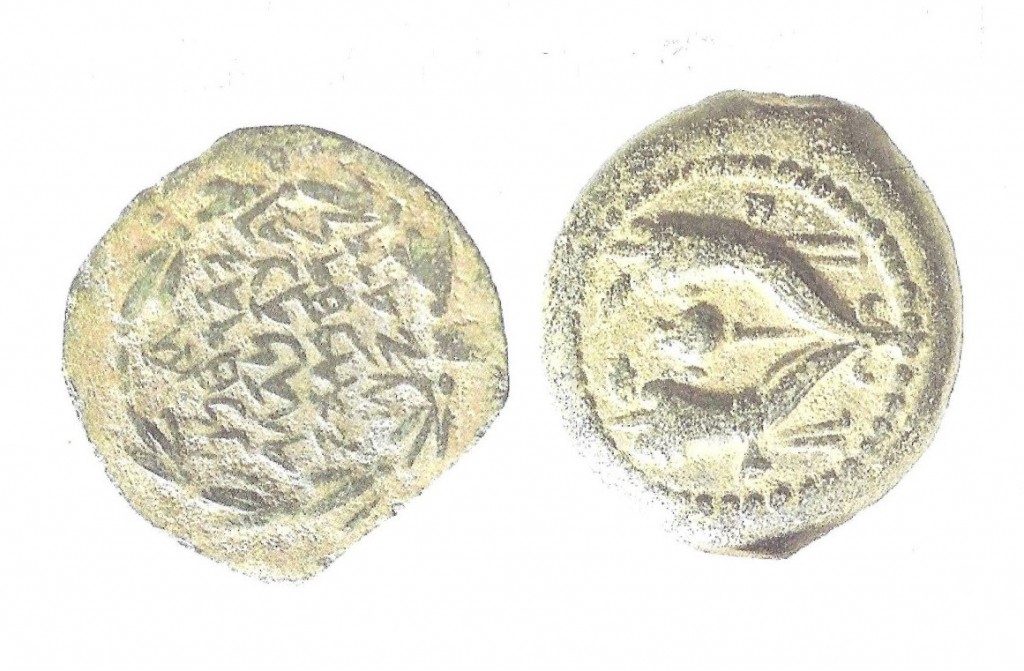
07.01.04.D. A COIN OF JOHN HYRCANUS II. A coin of John Hyrcanus II, the Jewish high priest (served 63-40 B.C.), has a double cornucopia that was based upon Greek mythology. It is another illustration to show that Jewish leaders chose not to cleanse their land from Greek paganism. Wikipedia Commons.
Statues of idols have been found in Caesarea Maritima, the city built by Herod the Great along the Mediterranean Sea. It was well populated by both Jews and Gentiles, and had a hippodrome, a theater that every tourist sees today, pagan temples, etc. Among the idols are two statues of healing gods shown below.
It was common practice among many cultures, that when a person was sick or injured, he or she went to the temple to discuss the matter with a priest. The priest would either create a body part out of clay or other material, or get a body part from a storage room where such pieces were kept. Clay or wooden reproductions of body parts were known as votive offerings.[41] The person in need of healing and the artificial body part were then anointed with prayer.
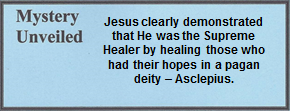
The following image can be found in the full single-volume eBook of Mysteries of the Messiah as well as in the corresponding mini-volume. Search for the following reference number: 07.01.04.E. STATUETTES OF HEALING GODS. LEFT: Portion of a marble statuette of the god Asclepius (height 26 cm; Courtesy of the Sedot Yam Museum). RIGHT: Portion of a statuette of his daughter, the goddess Hygieia (height 24 cm. Courtesy of the Israel Antiquities Authority). Both statuettes are of the first century and from Caesarea Maritima.
This practice was not restricted to the Greeks. First Samuel 6 records the account of when the Philistines captured the Ark of the Lord from the Israelites, the Philistines became sick with tumors and rats invaded their land. In response the Philistines asked their priests and diviners what they should do. The answer was to return the Ark with models of rats and tumors made of gold (1 Sam. 6:5). They did and were healed.
Finally, after this point, the religious leaders intensified two charges against the Prophet of Nazareth:
- He broke their rules that pertained to the Sabbath observances (Jn. 5:16, 18) and,
- He was a blasphemer of their God because He claimed equality with His Father (Jn. 5:17-18).
The first charge was reason for opposition, persecution, and possibly death. The second charge was serious enough to warrant the death penalty. But the problem was that the Romans had removed the authority for the Jews to inflict capital punishment. Therefore, Jesus was carefully observed for any possible charge that could bring Him before Pilate, which is what eventually happened.
[1]. On March 9, 2013, Dr. James H. Charlesworth of Princeton Seminary gave a report in Jerusalem in which he outlined several archaeological discoveries that support the historical reliability of the gospel of John. Essentially, he said that John knew the details of Jerusalem as it was prior to the A.D. 70 destruction, details that were unknown to archaeologists only a decade ago. For additional details, see “Gospel of John Backed by Archaeology.” Artifax. 28:3 (Summer, 2013), 11-12.
[2]. The Seven Signs: Water into Wine (Jn. 2:1-2); Healing the Nobleman’s Son (Jn. 4:46-54); Healing the Paralytic (Jn. 5:1-17); Feeding the 5,000 (Jn. 6:1-14); Calming the Storm (Jn. 6:15-21); Healing Man Born Blind (Jn. 9:1-14) and Resurrection of Lazarus (Jn. 11:17-45).
[3]. Interview with Arie bar David, tour guide and lecturer in August, 1999.
[4]. Mackowski, Jerusalem City of Jesus. 83.
[5]. Farrar, The Life of Christ. 199.
[6]. Edersheim, The Life and Times of Jesus the Messiah. 321 n8.
[7]. First and 2nd Maccabees belong to a classification of extra-biblical books known as the Apocrypha. These two literary works are deemed highly reliable historically. See 02.02.03 “Apocrypha” for more information.
[8]. See also Josephus, Antiquities 12.5.1-4.
[9]. Idols are not mentioned in the gospels because these statues to pagan deities were not permitted within Jewish communities. They were, however, prominent in Gentile communities within the Jewish regions and are mentioned elsewhere in the New Testament. Vine, “Idols.” Vine’s Complete Expository Dictionary. 2:317.
[10]. Farrar, Life of Christ. 173.
[11]. See the comments by Gordon Franz in 07.01.04.V2.
[12]. Other biblical examples are found in Mt. 25:41; Jude 6; 2 Cor. 11:13-15; and Rev. 19:20.
[13]. For additional information on the cult of Aesculapius, see Estee Dvorjetski,“Healing Waters.” 16-27, 60.
[14]. Furnish, “Corinth in Paul’s Time: What can Archaeology Tell us?” 25.
[15]. Stillwell, “Greece – The Birthplace of Science and Free Speech.” 250.
[16]. Zondervan’s New International Version Archaeological Study Bible. (2005 ed.). 1674.
[17]. Metzger, The New Testament. 223.
[18]. Zondervan’s New International Version Archaeological Study Bible. (2005 ed.). 1728; Shanks, “After Hadrian’s Banishment: Jews in Christian Jerusalem.” 26-36, 62.
[19]. Boring, Berger, and Colpe, eds. Hellenistic Commentary to the New Testament. 266.
[20]. For further study on the ancient descriptions of the cult of Asclepius, see Pausanias, Description of Greece 2.27.2; 10.32.8; 7.27.5; Aristophanes, Plutus 410:653ff; Wasps, 122; Strabo, Geography 14.1.44; Plautus, Curculio 1.1.61; 2.1.
[21]. Boring, Berger, and Colpe, eds. Hellenistic Commentary to the New Testament. 310.
[22]. Parenthesis for clarification are mine.
[23]. Giannelli, The World of Classical Athens. 211.
[24]. Horsley, New Documents Illustrating Early Christianity. 2:10-11, 21-23; Phillips, Man, Myth, and Magic. 5:1248.
[25]. Since the Feasts of Passover, Unleavened Bread, and First Fruits were celebrated within an eight-day period, these were generally referred to by the most important of the three feasts, Passover.
[26]. Mackowski, Jerusalem City of Jesus. 55; Vincent, Word Studies in the New Testament. 2:131.
[27]. Examples are found in Jerusalem: Center of the World, where various scholars present opinions, some of which are based on Gnostic gospels and other illegitimate writings. Goldberg and Suarez, Producers. Jerusalem: Center of the World. (DVD).
[28]. Bailey, Jesus through Middle Eastern Eyes. 292; Geikie, The Life and Works of Christ. 2:348.
[29]. An ostraca is a pottery fragment that was used as a writing surface or material, since papyri and parchment were extremely expensive. See “ostraca” in Appendix 26 for more details. An example is the King David Fragment at 03.02.01.A.
[30]. Bivin and Blizzard, Understanding the Difficult Words. 37.
[31]. Mishnah, Eduyoth 2.5; Mishnah, Sabbath 6.3; Mishnah, Mekilta Exodus. 22.2; 23.13.
[32]. An excellent resource for further Sabbath study is Hagner, “Jesus and the Synoptic Sabbath Controversies.” 270-88.
[33]. For more information, see “02.02.18 Oral Law,” “02.02.20 Oral Tradition,” and especially Jubilees 50:6-13 at 02.04.06. In fact, during the Maccabean Revolt, since the Jews refused to fight on the Sabbath, the Greeks slaughtered more than a thousand men, women, and children. Thereafter they decided to defend themselves as not be removed from the face of the earth (1 Macc. 2:31-38).
[34]. Josephus, Antiquities. 1.1.1.
[35]. Jeremias, Jerusalem in the Time of Jesus. 198.
[36]. For more details on this important point, see 09.01.03.Q1 “What was the significance of the Beelzebub discussion?”
[37]. Adapted from Fruchtenbaum, The Jewish Foundation of the Life of Messiah: Instructor’s Manual. Class 10, page 17.
[38]. The Seven Signs: Water into Wine (Jn. 2:1-2); Healing the Nobleman’s Son (Jn. 4:46-54); Healing the Paralytic (Jn. 5:1-17); Feeding the 5,000 (Jn. 6:1-14); Calming the Storm (Jn. 6:15-21); Healing Man Born Blind (Jn. 9:1-14) and Resurrection of Lazarus (Jn. 11:17-45).
[39]. For more information, see 03.05.12, “Summary Influence of Hellenistic Reform” (331-63 B.C.)
[40]. Ancient coins are cleaned and restored by a process known as the Deep Proton Activation Analysis.
[41]. In churches that still consider votive offerings today, the parishioner can give gifts such as candles, flowers, or monetary donations.